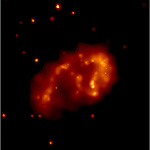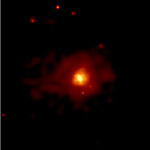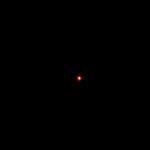These four verisions of the Eta Carinae Chandra data have been processed to show how Eta Carinae looks at three different X-ray energies. Courtesy M. Karovska, Harvard-Smithsonian Center for Astrophysics.
1
Eta Carinae, Chandra X-ray
Chandra image of Eta Carinae at the lowest X-ray energies. The radiation from gas around 3 million degrees Celsius is especially prominent here. This image shows that the 3 million degree Celsius gas is spread out in a broad diffuse horseshoe-shaped region that is about 2 light years across.
(Credit: NASA/CXC/SAO)
Chandra image of Eta Carinae at the lowest X-ray energies. The radiation from gas around 3 million degrees Celsius is especially prominent here. This image shows that the 3 million degree Celsius gas is spread out in a broad diffuse horseshoe-shaped region that is about 2 light years across.
(Credit: NASA/CXC/SAO)
2
Eta Carinae, Chandra X-ray
Chandra image of Eta Carinae at medium X-ray energies. The radiation at these energies is from gas that has a temperature in the range 30 to 60 million degrees Celsius. This images shows the bright central area that is about 3 light months across.
(Credit: NASA/CXC/SAO)
Chandra image of Eta Carinae at medium X-ray energies. The radiation at these energies is from gas that has a temperature in the range 30 to 60 million degrees Celsius. This images shows the bright central area that is about 3 light months across.
(Credit: NASA/CXC/SAO)
3
Eta Carinae, Chandra X-ray
Chandra image of Eta Carinae at high X-ray energies. At these energies, Eta Carinae is less than a light month across. This radiation could be coming from hot material very near the central star.
(Credit: NASA/CXC/SAO)
Chandra image of Eta Carinae at high X-ray energies. At these energies, Eta Carinae is less than a light month across. This radiation could be coming from hot material very near the central star.
(Credit: NASA/CXC/SAO)
4
Eta Carinae, Chandra X-ray
Composite Chandra image of Eta Carinae made by combining the data at all energies.
(Credit: NASA/CXC/SAO)
Composite Chandra image of Eta Carinae made by combining the data at all energies.
(Credit: NASA/CXC/SAO)
Return to Eta Carinae (08 Oct 99)







